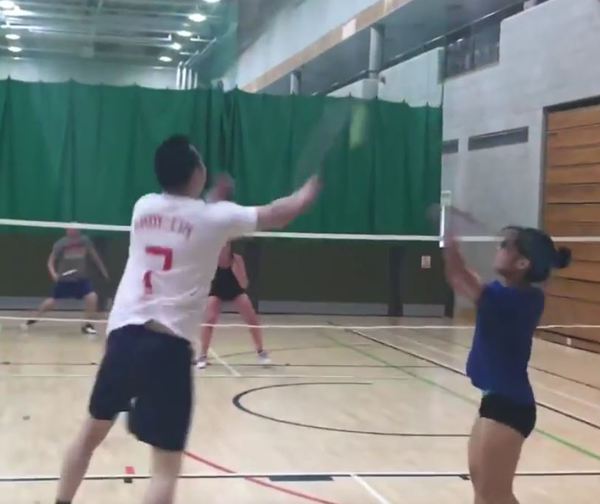First of all, your footwork and technique is superior to all other players on that court. I Think you'd have trouble to cope with a higher speed when playing with (against) better players though. The basics are there, but there's always a lot to work on.
It looks like you use the same grip for every single shot. This lmits you and will lead to awkward movements. Paul Stewart has a
video on changing the grip between forehand (basic/ V-/...) grip and backhand (thumb) grip. Actually, you might be doing what he is mentioning as a mistake at the beginnign of the video. This will not only make it more difficult to change grips, but also limit the effect of forearm rotation (pronation/supination), but first things first. Here are some pictures of the most common grips:

Don't worry about the german words too much. At the top (right), it's the basic/forehand/V-grip, left is the thumb/backhand grip and at the bottom right is the rush/panhandle grip. The illustrations are for right handed players, but i guess you get the picture. To me, it looks like you are using something in between the forehand grip and the rush grip for every shot. It's good to know that, but you should pratice to change grips between rush/panhandle, basic/forehand, and thumb/backhand grip, but please keep in mind that thos grips are the extreme sides of it and most shorts will be played with something in between. For example, most backhand shots will be played with a grip between the basic/forehand and the thumb/backhand grip by just taking your thumb to sit with its side at the edge of the handle instead of taking a full backhand grip (thumb completely on the flat side of the handle). Actually, I teach to use the full backhand grip only when serving (most people will use it when needed without teaching them when they know the technique).
Another important point about grips is to have a relaxed grip, so you can tighten your hand at (or just before) the point of impact to give som extra power (smash, clear, ...) or even to execute deceptive shots (flick (serve), ...). In Germany, coaches like to think about it using triangles:

Therefore, it is important that your grip is correct (see Paul's video).
Then, you already identified taking a shuttle low at the back as one of your weak points. I think this is due to missing/weak pronation (inward rotation) of the forearm. And this might be due to the grip (see above and the beginning of Paul's video). Using pronation (supination), you can hit powerful forehand (backhand) drives from the backcourt. I didn't go through it, but normally, the
badminton bible is a good resource. Good rotation will also help to produce more powerful shots in different situations when you cannot use your body (you're doing very well there, when you have anough time!), like (but not limited to) a stick smash or any stroke using a china jump (as mentioned by others before).
That was a lot already, but I think that's some basics you are missing/need to improve, but there is more that's not obvious against opponents like that. I'll ry to keep it short though

.
When playing against opponents who try to rush your serve, it will become obvious that it's too high and too inconsistent. Good news: It's the easiest shot to practice. While some will say your technique on it is good, I'd change it. I've been tought at least three different ways of doing it by four high level coaches, so I've tried for myself and let others try and I prefer this way:
- (not that important, but since you already do it anyway) put your racket foot in front
- use a backhand (full thumb) grip; relaxed grip as always
- hold your racket arm (almost) at shoulder height, the elbow very slightly bent
- angle the racket (shaft) just slightly downwards (around four o'clock for a leftie)
- tilt the racket such that the strings are facing slightly upwards*, so the shuttle will fly upwards
- slightly shift your weight/balance to your front (racket foot); this will make shure you have enough space between the shuttle and your body
- hold the shutte with your thumb and index finger only (like a dirty sock), getting the other fingers out of the way (either bending or spreading them)
- put the shuttle in front of the strings, the cork will be tilted towards the strings slightly
- stabilize the entire system by touching the racket (always the same spot of the frame) with the metacarpal of your thumb
- pull back the racket, dont change the angle of the racket compared to the floor/net/... anything fixed by bending (flexing) your elbow
- push the racket straight through the shuttle; put just enough pressure on your fingers so the impact will not move your racket (a flick serve is achieved by tightening your hand explosively at the point of impact
*vary this angle to get the best path of the shuttle, then vary the strength of the shot to hit the line consistently
As said before, there are other ways of doing a backhand serve, but this one has a few advantages. It will let you prepare in the same way every time. Even if you are weak, you can hit a good flick serve with the same preparation. It is a very very straight movement, so it's not prone to errors even in very tense situations.
What I see most people (kids) forgetting about is to (slightly) shift their balance on their front (racket) foot. They'll start trying to hit using their wrists again which will be much less consistent, so don't forget about that if you try this.
Alright, that was pretty detailed again, but maybe it helps to actually help you with the serve. Some other things were pointed out by others, like keeping the racket up at the net, better (earlier and quicker) preparation for overhand shots, better perception and awareness of the situation (position of partner, position of opponents, your position AFTER hitting), .... There always is a lot to work on!
That being said, you are doing great, you are doing many things correctly and I'd be so happy to have more people with your basics in the groups I coach, because that seems to be rare. Keep improving! And don't worry about getting critique here, coaches are trained to find and point out mistakes. If something is good or even perfect, it's just not worth mentioning.




